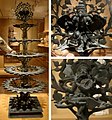Nilavilakku




Nilaviḷakku ⓘis a traditional lamp used commonly in Kerala as well as in Tamil nadu, called Kuthuviḷakku in Tamil (குத்துவிளக்கு) . It is called Deepada Kamba (ದೀಪದ ಕಂಬ) in Karnataka[1] and Samai (समई) in Maharashtra. In Odisha, its called Pilisajā/Pilibeṛhi (ପିଲିସଜା /ପିଲିବେଢ଼ି) in Odia. The traditional lamps which is lit during every auspicious occasions; in temples before the worship starts; at the official and unofficial functions.
Etymology
[edit]Nilam in the Malayalam/Tamil[1] language means floor or the ground and vilakku means lamp.
Usage
[edit]History
[edit]Vilakku/dīpam (lamp) is one of five accessories of religious worship in Hinduism, Jainism and Buddhism; others being puṣpa (flowers), dhūpa (incense), gandhā (sandalwood paste) and nivedya (food). Worshipping deities with these five accessories is generally considered as a way for achieving the four ends of human life; dharma, artha, kama and moksha.[2]
The Nilavilakku is integral to several rituals and ceremonies in Hindu families in Kerala. As the sun sets, young girls of the family bring the lighted lamps to the verandah of the house, continued with evening prayers. In the evening the ritual is repeated alongside evening prayers. In Hindu temples, various types of Nilavilakku like 'Kutthuvilakku', 'Thookkuvilakku' etc. are used and are very much related to the traditional beliefs and activities in Kerala.
Lighting the Nilavilakku on any occasion is believed to be auspicious. Nilavilakku plays an important role in the presentation of various art forms. The art forms are performed after lighting the lamp. In Kerala, many functions are inaugurated by lighting Nilavilakku.[3] A special type of Nilavilakku, called Aal Vilakku is used in Temples of South India, especially in Kerala.[4]
Nilavilakku is usually made of bronze or brass. Usually cotton wicks doused in oil or ghee are used for lighting the lamp. There are three ways of lighting the lamp. In one, only one wick is lit and is directed towards the deity or sacred space and in another there are two lit wicks in two directions. The third alternative is with five wicks in five directions.
In Kerala, Saint Thomas Christians also started keeping Nilavilakku in their churches and homes. Traditionally, the nilavilakku is lighted and kept at the main front entrance of a home. Syrian Christian art forms like Margamkali and Parichamuttukali are performed around nilavilakku.
Gallery
[edit]-
13th century lamp, Kerala
-
a lighted up nilavilakku
-
Kuthuvillaku, Tamil Nadu
-
Nilavilakku, Tamil Nadu
-
Bronze lamp in 13th century, Kerala
-
Nilavilakku lamps in typical Kerala style
-
Nilavilakku lamps, Kerala
-
Nirapara and Nilavilakku
-
Bronze lamp used in Temples.
-
Hanging lamp
-
Hanging lamps
-
Nilavilakku in Church with Christian cross
See also
[edit]- Other lamps
- Related topics
References
[edit]- ^ a b RRV. "South Indian Traditional Nilavilakku 12 Inch tall". www.DanceCostumesAndJewelry.com. Retrieved 11 April 2018.
- ^ Sociology of Religion in India (2001) - Page 287, M. G. Nayar
- ^ "Nilavilakku - The Kerala's Traditional Oil Lamp - Neokerala". Neokerala. 21 June 2017. Retrieved 11 April 2018.
- ^ [1]|www.jaya-he.com/aal-vilakku












